Best Brake Pads
The Drive and its partners may earn a commission if you purchase a product through one of our links. Read more.
Noisy brakes? That diabolical screeching every time you hit the brakes is more than just an annoyance; rather, that's your brake pads giving you one final warning before things truly get ugly. Hoping it will go away, or that it's just a stubborn chunk of rust gnashing around in there, is misplaced optimism that can have dire and expensive consequences. When the screeching stops, the heavy metal wreckage begins.
Putting a piece of tape or "I Voted" sticker over the brake warning light won't help either. But if you catch brake pad wear early, you might be able to swap in a new set and go. Disc brake pads, calipers, and rotors work together for predictable stops. When you hit the brake pedal, the caliper clamps the pads onto the rotor, creates friction, and converts kinetic energy into heat as you slow down. And there's a lot of heat. That's the main reason brake pads and rotors wear out as they work. And that's why regular brake inspection and maintenance keeps you and everyone else safe on the road.
What you drive and how you drive it are the deciding factors in choosing the best brake pads. Brake systems are factory engineered for the vehicle, but everyone has a different driving style. One driver's grocery-getter is another's world rally car.
Stock replacement brake pads are the right choice in most cases, and if you want or need something more, there are plenty of options to match your needs. We put together a selection of brake pads as part of a full brake overhaul, so read on and find the best brake pads for your ride and your driving style.
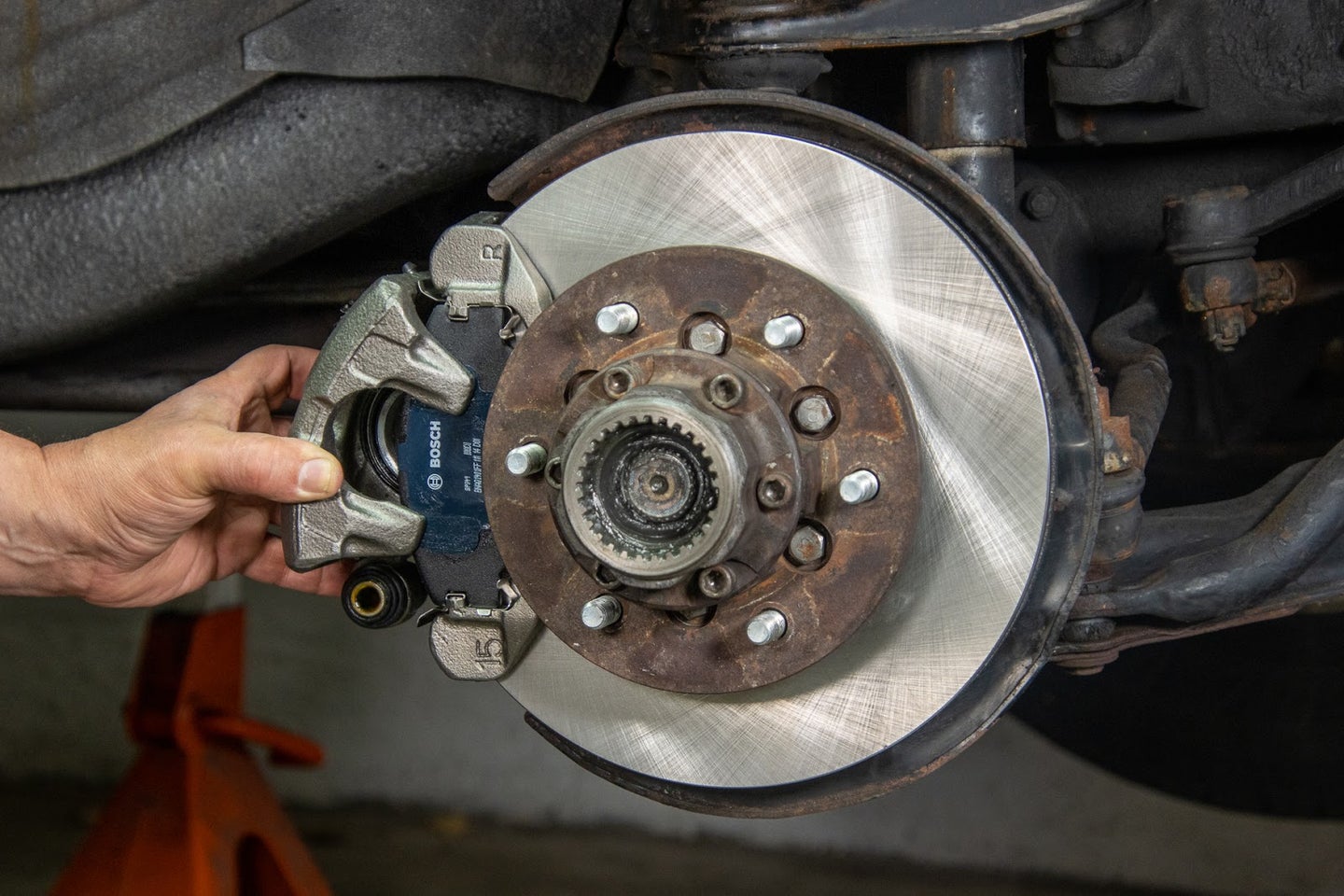
THIS IS A DRIVE HANDS-ON REVIEW
Mike Bumbeck
When he's not wrestling with one or more first-generation Mitsubishi Monteros and other fine '80s-era Japanese cars and motorcycles, Mike Bumbeck evaluates a constant variety of automotive products from The Drive's clandestine Science Barn testing facility in New England.
Why Trust Us
Our reviews are driven by a combination of hands-on testing, expert input, "wisdom of the crowd" assessments from actual buyers, and our own expertise. We always aim to offer genuine, accurate guides to help you find the best picks.
Learn more
About Our Brake Pad Review
Our brake pad installation test and review was part of a complete brake overhaul on our rust-ravaged 1989 Mitsubishi Montero. Road salt and corrosion damaged the brake calipers and rotors beyond repair, so we opted for a total disc brake job. Ironically, the brake pads still had some meat on them, but we purchased a selection of stock replacement brake pads along with new rotors and remanufactured calipers for the task. Materials, quality, grade, and ease of installation were deciding factors.
From a DIY standpoint, the best brake pads come with everything you need to get the job done. And since the Montero won't be running the Dakar Rally or towing a boat anytime soon, the standard stock replacement grade was the way to go.
Benefits of Brake Pads
- Safety. Built-in materials make a loud screeching noise when brake pads reach their safe wear limit. Listen and replace; don't wait.
- Performance. The brake pads, disc rotor, and caliper work together as a whole. Worn out brake pads can cause unpredictable and dangerous braking performance overall.
- Savings. Complete brake jobs are more expensive than brake pads. Inspect and replace your brake pads before the rotors and calipers are damaged beyond repair.

Mike Bumbeck
Brake pad wear indicators make contact with the rotor and a loud noise occurs when the pad material is at the safe limit. That ear-splitting metal-to-metal screeching is your brake pads telling you it's time for brake service. Newer cars have electronic brake pad wear indicators that trigger a warning light
Types of Brake Pads
Friction Materials
Brake pads fall into types based on their friction materials, and each blend has its advantages and drawbacks. Brake pad formulations are a closely guarded secret, and there are no standard definitions of what combination or percentage of materials makes one brake pad ceramic and another organic. Upcoming regulations on copper content are changing material use industry-wide.
Brake pad materials often vary within the same product line, depending on the platform. TRW lists copper-free ceramic, semi-metallic, and low metallic within its same Ultra series. Our Wagner TQ ThermoQuiet brake pad set was a new ceramic formula part number that replaced an older semi-metallic part number. Friction materials are less critical than brake pad grade. Choose a value line, stock replacement, premium, high-performance, or heavy-duty brake pads based on your driving needs.
Organic
Predictable, quiet performance that meets most drivers' everyday needs makes NAO organic brake pads the most common type. Not to be confused with organic broccoli rabe or garbanzo beans, organic brake pads can contain a blend of materials including fibers, rubber, glass, carbon, ceramics, metals, Kevlar, and resins that bind everything together. The NAO stands for non-asbestos organic. Asbestos was a common brake pad friction material until it was determined to cause irreversible lung damage and cancer.
Organic pad compounds are easier on rotors than others, and while they can wear out faster, they are generally the least expensive. The forgiving formulations don't stand up to the heat of repeated heavy braking, and dust can be a concern. Most new vehicles roll out of the factory with organic brake pads, so look for stock replacement pads to restore original performance. NAO low metallic organic brake pads can have some metals in the mix, but the percentage generally falls under 30 percent.
Metallic
Semi-metallic and metallic brake pads pick up where organic brake pads fade away. Brake pads with over 30-60 percent metal content make up the majority of this category. The higher metal percentage improves stopping power and fade resistance with superior heat transfer over organic formulas. Full metallic and sintered metal brake pads more common on motorcycles and ATVs than cars and trucks.
Semi-metallic brake pads perform well in cold and hot temperature extremes with superior durability over organics. The more aggressive bite and resulting heat can accelerate rotor wear. Depending on the metal percentage and material blend can be noisy and create excessive dust. Some compounds require a break-in procedure. A wide range of formulations from daily driving to high performance makes semi-metallics a popular choice.
Ceramic
Ceramic brake pads are the latest in pad technology and can deliver the best of all worlds with excellent performance, durability, and quiet, low dust operation. The dense combination of kiln-fired ceramic material like porcelain blended with carbon, ceramic and metallic fibers, graphite, fillers, and binders varies by manufacturer. Ceramics are the most expensive type of brake pad but are more durable than organics or semi-metallics.
If ceramic brake pads make noise, you likely won't hear it, as the frequencies are outside the range of human hearing. Low wear and tear on rotors and low dust are another bonus, and ceramic dust is less noticeable due to its lighter color and low adhesion. Some formulations can be problematic in extreme cold or high-performance applications. Ceramics are increasingly popular as original equipment and offer a durable choice for daily-driven vehicles.
Top Brands
Bosch
Bosch Automotive is the aftermarket automotive parts arm of Bosch, a multinational electronics and engineering company with a reputation for manufacturing premium products for the automotive, home, and industrial markets. Bosch is an OEM supplier for automakers worldwide, and its extensive line of aftermarket automotive parts meets or exceeds original equipment quality and performance standards. Bosch QuietCast brake pads earned our best overall rating for our application.
Wagner
H.A. Wagner founded the Wagner Electric Manufacturing Company in St. Louis, Mo., in 1891 with a self-starting desk fan motor that relegated hand cranking to history. Wagner moved into the burgeoning horseless carriage market with lighting and brake products, and today the company is a global leader in those segments. Wagner manufactures a wide range of automotive brake parts and lighting components for passenger car, medium-duty and commercial applications.
TRW
The TRW brand is part of ZF Aftermarket and ZF Group, a global leader in driveline, chassis, suspension, and safety systems technology. ZF Aftermarket brings a full line of original equipment quality components to professionals and consumers, and TRW manufactures a wide range of brake, steering, and suspension parts. Innovative engineering backed by in-house and independent testing house testing ensures quality and performance.
Brake Pad Pricing
- Under $25: Economy or value grade brake pads might get the job done but often come with the tradeoff of reduced durability and performance. Closeouts and discontinued parts can be a bargain but keep an eye on shelf life.
- $25-$65: The majority of high-quality stock replacement brake pads in a wide variety of material formulations and grades fall into this price range. Expect original or better performance and durability that can stand up to daily use in driving conditions.
- $65 and up: Specialized factory performance, premium or larger sized brake pads demand a higher price. Improved stopping power in high heat situations can come at the cost of safe driving in everyday low-temperature operation.
Key Features
Making the Grade
Manufacturers engineer and test brake pad materials to meet or exceed the platform's original equipment specifications and offer a range of performance grades and product lines to suit the driver's needs. If your F-150 is a light commuter, then stock replacement grade pads are the best choice. If you haul around a boat or another truck with your F-150, then grab some premium or heavy-duty grade brake pads. Friction materials and formulas can vary within the same grade by platform so choose the brake pad grade that matches your needs.
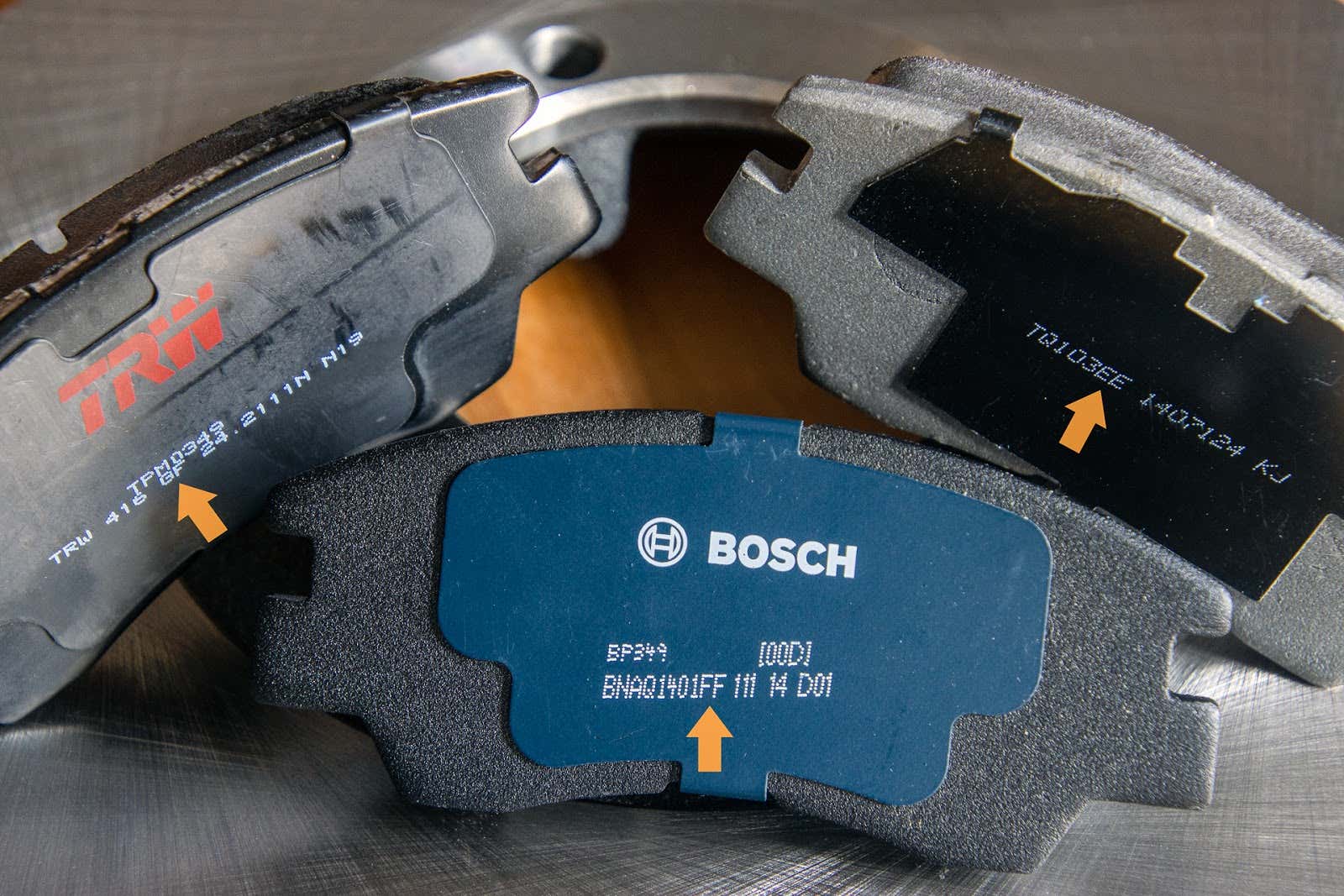
Mike Bumbeck
Orange arrows point to two letter brake pad coefficient of friction ratings. TRW is rated GF, Bosch QuietCast FF, and Wagner TQ ThermoQuiet EE. New copper content requirements are changing brake pad material formulations industry-wide, with ceramic formulas at the forefront.
Letters and Leaves
A two-letter DOT grading system printed or stamped on every brake pad designates the coefficient of friction or COF at cold and hot operational temperature ranges. Higher letters represent higher COF. Most replacement pads have an EE or FF rating. A GF rated pad has more cold bite, and a GG is more aggressive hot and cold for high-performance or heavy-duty applications. The letters are more guidelines than gospel due to differences in brake pad thickness, cooling slots, chamfers, construction, and rotor designs.

The three-leaf symbol indicates compliance with regulations concerning toxic and environmentally harmful materials. One leaf means the brake pads meet Level A requirements for cadmium, chromium, lead, mercury and asbestos. Two leaves or Level B meets Level A standards as well as 2021 limits on copper content set by legislation in Washington and California due to water runoff contamination. Three leaves or Level N means compliance with standards that mandate less than 0.5 percent total copper or "copper-free" by 2025.
Pedal Feel
A firm brake pedal is constant reassurance of braking performance. Brake pad compounds play a role. Organic brake pad materials tend to be softer and compressible and can result in a softer or spongy pedal. Semi-metallic or ceramic compounds are less compressible than organics and provide a firmer brake pedal feel overall. Spongy or excessive brake pedal travel can also result from air in the system, worn or leaking hydraulic lines, or a malfunctioning brake power booster.
Hardware, Shims, and Grease
If you're doing the job yourself, note what is or isn't included. Brake pad sets are sold per axle or as a full set for both axles or all four wheels. Some brake pads sets come with all the hardware, grease, shims, and even caliper pin seals to get the job done. Some sets don't, but this isn't a DIY deal-breaker. Our brake job was a good example. The Wagner ThermoQuiet set only came with shims, but the remanufactured calipers came with replacement clips and caliper grease. Success!
Operating Temperature
Excessive heat is the enemy of brake pad durability and performance. Your driving style and operating environment are key factors when choosing brake pads. Everyday driving can heat the brakes to 400 degrees, and stock replacement pads can handle short bursts of higher temperatures without fading. Sustained 500-degree temperatures created from all day stop-and-go urban driving can accelerate wear. Towing, hauling, and high-performance street or track driving can push temperatures past 1000 degrees and literally melt stock brake pads.
Other Considerations
- Matched Set: If the last set of brake pads left your rotors beyond resurfacing, a pad and rotor set might be the answer. Rotors and brake pads engineered to work together can deliver durable and consistent performance and take the guesswork out of a brake job.
- False Economy: Saving money on no-name brake pads might not be much of a bargain, and assured safety is always worth the extra coin. Untested compounds with unknown ingredients can be dangerous on the road and in the shop.
- Loaded Calipers: If the brake calipers are frozen solid or look like the wreck of the Titanic loaded calipers can help. Loaded calipers come loaded up with new brake pads, hardware and a bleed screw that actually turns for a no hassle remove and replace.
- Street Racer: Competition or racing brake pads are ineffective at low temperatures and can perform far worse than stock replacement pads in everyday driving. Race specification brake pads work best at track-generated high temperatures.
Brake Pad Reviews & Recommendations 2021
Best Overall
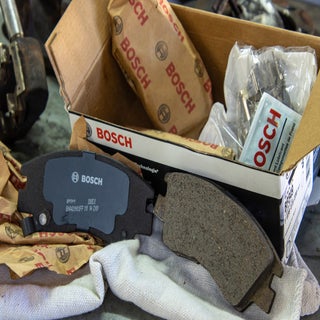
The Bosch QuietCast line of brake pads and rotors meet or exceed original equipment performance for a wide range of domestic and imported vehicles. Bosch is an OEM brake parts supplier, and its aftermarket products undergo the same level of testing. QuietCast brake pads feature semi-metallic or ceramic friction material formulations engineered for platform-specific performance. QuietCast Premium brake pads are a step up from the Blue value line, and Bosch offers a Severe-Duty lineup for taxis, police, and heavy hauling.
There was no QuietCast disc rotor part number for the Montero, so we only picked up a set of brake pads for review. Part number BP349 features semi-metallic friction material with a rubber core shim adhesive-bonded to the back of the brake pad, and the set came with caliper hardware and high-quality grease. The QuietCast set earned our overall best brake pad pick with its premium quality apparent from the second we opened the box. Each brake pad came individually wrapped in paper that added a premium touch that helped prevent grease contamination during installation.
Best Value
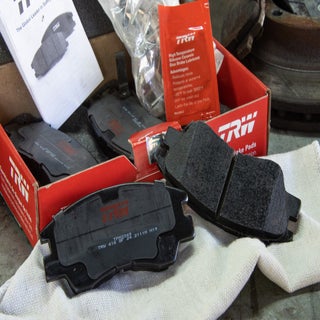
The TRW brake pad set came in a few dollars under our other contenders on price and beat them on quality and performance rating. TRW part number TPM0349 came complete with hardware, grease, instructions, and most importantly a high-quality set of brake pads. The semi-metallic pad material carries a high GF coefficient of friction rating with a cooling slot and chamfers that help prevent excessive heat buildup for reduced fade.
The large nitrile rubber-coated steel shims are bonded to the pads for quiet operation. The TRW pads feature silicate-compound Citec or Coating Innovation Technology that helps the pad material break in properly with the rotor. Platform engineered material compounds undergo high-temperature testing to deliver better than original equipment fade-free performance with low dust. TRW brake pads are a high-quality choice with excellent value if you're looking for a mild performance upgrade.
Honorable Mention
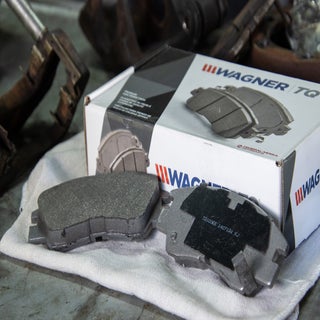
Wagner TQ ThermoQuiet brake pads take up the middle ground of the product line that's a notch up from stock replacement but not quite heavy-duty or high performance. The quiet in ThermoQuiet comes from the Wagner Integrally Molded Insulator or IMI. The one-piece design fuses the friction material, backing plate, and insulator together to reduce vibration and noise while increasing heat transfer for improved performance. The Wagner TQ line meets the latest Level N zero-copper requirements.
We've used ThermoQuiets on other brake jobs, and they live up to their promises. The pads were easy to break in on resurfaced rotors, and the proprietary friction material delivers quiet and effective braking. The ceramic formulation strikes the right balance of performance and durability with little or no dust in the process. The PD349 part number we picked up for the Montero is an example of why manufacturer grade is more important than material when choosing brake pads. Ceramic formula PD349 superseded semi-metallic part number MX349 for the same application.
More Brake Pad Choices
There simply aren't a lot of brake pads part numbers out there for our oddball first-generation Mitsubishi Montero here in the states, but we've tried dozens of different brake pads over the years on everything from muscle cars to econoboxes. We've had good luck with Bendix, Beck-Arnley, Raybestos, and Centric brake pads and shoes in the past. OEM suppliers like Akebono and AC Delco are solid choices for aftermarket brake pads. StopTech and Power Stop offer performance engineered brake pad and rotor packages. If you're looking for a no-brainer replacement, remember that genuine manufacturer parts don't always cost much more than aftermarket equivalents. Cheaping out on brakes is like getting a great deal on brain surgery.
Tips
- Inspect your brake pads regularly. Most brake calipers make it fairly easy to keep track of brake pad wear. Grab a flashlight every 10,000 miles or so and take a look. Keep an eye out for uneven wear and an ear open for noise from the wear indicators.
- New brake pads won't help if the rotor looks like it would play Van Halen's "Runnin' with the Devil" if you put it on a turntable. A brake pad remove and replace or "pad slap" is less common than not. Resurface or replace rotors before installing new brake pads.
- Never use compressed air or anything else that makes dust to clean brakes. Brake pad dust may contain trace amounts of asbestos and other harmful chemicals. Use liquid brake parts cleaners. Do not breathe brake dust or brake cleaner vapors. Wear a mask.
FAQs
Q: How do brake pads work?
Brake pads sit inside the caliper and go along for the ride until you hit the brakes. The brake pedal lever pushes a piston inside the master cylinder that creates hydraulic pressure. Brake fluid is incompressible, and it pushes another piston inside the brake caliper that clamps the brake pads onto the rotor. Friction between the brake pads and the metal rotor slows things down as kinetic energy transforms into heat.
Q: What are the symptoms of worn-out brake pads?
The most obvious symptom of worn out brake pads is a loud squealing or screeching noise when you hit the brakes. Built-in wear indicators contact the rotor and sound off when the friction material wears beyond its limit. Electronic wear indicators activate a brake wear warning light. Brake shudder, scraping or grinding noise, and poor brake performance probably time for new brake pads, rotors, and possibly calipers.
Q: How long do brake pads last?
Brake pads last anywhere from 30,000-70,000 mile range. Check your owner's manual for service intervals. Driving style and location play a role. Stop and go urban driving, high-performance motoring, and heavy-duty hauling or towing can accelerate brake pad wear. Short distance or infrequent driving where road salt is used can ruin brake calipers and rotors long before the pads wear out. Visual inspection is the best way to detect brake pad wear.
Q: How much does it cost to replace my brake pads?
Total parts and labor cost depends on the overall condition of the brake system. If the rotors, calipers, and hydraulic lines are in good shape, expect to pay a repair shop about $100-400 per axle or two wheels. Some repair shops might be able to resurface your rotors, but installing new rotors and pads together is a more common practice. Replace worn rotors, frozen calipers, or rotten hydraulic lines with brake pads for safety and performance.
Q: Can I replace my brake pads myself?
Yes and maybe. A brake job can be the first step into a lifetime of automotive DIY enjoyment, but all disc brake systems are not created equal. Sliding calipers and non-captive rotors are easy to service, but new brake pads won't fix thin rotors or crusty calipers. Captured rotor setups that require removing the hub, wheel bearings, and seals with specialized tools then fighting rusty bolts to separate the rotor might have you calling the tow truck in defeat.
Q: How do I break in my brake pads?
The procedure varies by brake pad. The idea is to introduce the new brake pad material to the rotor surface for a lifelong partnership. Map out a low-speed route with little or no traffic. Accelerate to about 30-35 mph. Apply light brake pressure to slow down but not stop. Let off the brakes and resume speed for a minute-long cooldown. Repeat the go, slow, cruise procedure about five times. Increase speed to 50-55 miles per hour and repeat again. Gradually increase the intensity of the heating and cooling process. Avoid panic stops or sustained hard braking for the first few hundred miles. Excessive heat can permanently damage new brake pads.
Final Thoughts
Take a moment and appreciate your brakes. Imagine a 2-ton flaming ball of metal, plastic, toxic chemicals, glass, and rubber hurtling down a hill at tremendous speed, then calmly stopping it cold in its tracks with just one foot as you order up a coffee. Every time you hit the brakes, you achieve this Herculean feat.
The best brake pads for most drivers are the stock replacements from the vehicle manufacturer, or aftermarket original equipment OE equivalents. Some brake pad manufacturers are also OE suppliers, and aftermarket brake pad product lines offer a more comprehensive selection of premium, heavy-duty, performance, and severe-duty choices.
MORE TO READ
-
Best Car Brakes: Generate Reliable Stopping Power
Reliable car brakes are essential for safe, care-free driving
READ NOW
-
Best Brake Bleeder Kits: Get on the Pro Level
Your helper's calves will thank you
READ NOW
-
Best Brake Caliper Grease: Keep Your Vehicle Stopping Smoothly
The best brake caliper greases for maintaining stopping power.
READ NOW
-
Best Brake Calipers: Brake More Smoothly and Efficiently
Add some distance between you and the car in front of you with these powerful brake calipers
READ NOW
-
Best Brake Fluids: Get The Ultimate Stopping Power
The best brake fluids to keep your vehicle's braking system in tip-top shape
READ NOW
Source: https://www.thedrive.com/reviews/27690/best-brake-pads

Tidak ada komentar: